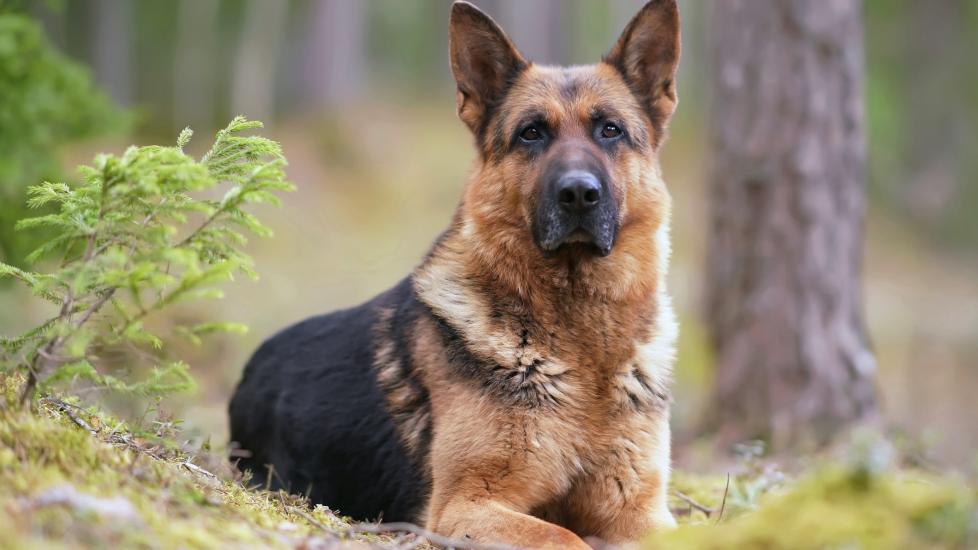The left half of the image shows the estimated difference in a dog's vision. Dogs' senses include vision, hearing, smell, taste, touch, and magnetoreception. One study suggests that dogs can feel small variations in Earth's magnetic field. Dogs prefer to defecate with their spines aligned in a north–south position in calm magnetic field conditions.
Dogs' vision is dichromatic; their visual world consists of yellows, blues, and grays.[ They have difficulty differentiating between red and green, and much like other mammals, the dog's eye is composed of two types of cone cells compared to the human's three. The divergence of the eye axis of dogs ranges from 12 to 25°, depending on the breed, which can have different retina configurations. The fovea centralis area of the eye is attached to a nerve fiber, and is the most sensitive to photons.Additionally, a study found that dogs' visual acuity was up to eight times less effective than a human, and their ability to discriminate levels of brightness was about two times worse than a human.
While the human brain is dominated by a large visual cortex, the dog brain is dominated by a large olfactory cortex. Dogs have roughly forty times more smell-sensitive receptors than humans, ranging from about 125 million to nearly 300 million in some dog breeds, such as bloodhounds. This sense of smell is the most prominent sense of the species; it detects chemical changes in the environment, allowing dogs to pinpoint the location of mating partners, potential stressors, resources, etc. Dogs also have an acute sense of hearing up to four times greater than that of humans. They can pick up the slightest sounds from about 400 m (1,300 ft) compared to 90 m (300 ft) for humans. Dogs have stiff, deeply embedded hairs known as whiskers that sense atmospheric changes, vibrations, and objects not visible in low light conditions. The lower most part of whiskers hold more receptor cells than other hair types, which help in alerting dogs of objects that could collide with the nose, ears, and jaw. Whiskers likely also facilitate the movement of food towards the mouth. CoatThese breeds possess distinct traits related to morphology, which include body size, skull shape, tail phenotype, fur type, and colour. As such, humans have long used dogs for their desirable traits to complete or fulfill a certain work or role. Their behavioural traits include guarding, herding, hunting, retrieving, and scent detection. Their personality traits include hypersocial behavior, boldness, and aggression. Present-day dogs are dispersed around the world. An example of this dispersal is the numerous modern breeds of European lineage during the Victorian era.
TailA dog's tail is the terminal appendage of the vertebral column, which is made up of a string of 5 to 23 vertebrae enclosed in muscles and skin that support the dog's back extensor muscles. One of the primary functions of a dog's tail is to communicate their emotional state.[53] The tail also helps the dog maintain balance by putting its weight on the opposite side of the dog's tilt, and it can also help the dog spread its anal gland's scent through the tail's position and movement.[54] Dogs can have a violet gland (or supracaudal gland) characterized by sebaceous glands on the dorsal surface of their tails; in some breeds, it may be vestigial or absent. The enlargement of the violet gland in the tail, which can create a bald spot from hair loss, can be caused by Cushing's disease or an excess of sebum from androgens in the sebaceous glands.[55]
A black Standard Schnauzer with a docked tail A study suggests that dogs show asymmetric tail-wagging responses to different emotive stimuli. "Stimuli that could be expected to elicit approach tendencies seem to be associated with [a] higher amplitude of tail-wagging movements to the right side".[56][57] Dogs can injure themselves by wagging their tails forcefully; this condition is called kennel tail, happy tail, bleeding tail, or splitting tail.[58] In some hunting dogs, the tail is traditionally docked to avoid injuries. Some dogs can be born without tails because of a DNA variant in the T gene, which can also result in a congenitally short (bobtail) tail.[59] Tail docking is opposed by many veterinary and animal welfare organisations such as the American Veterinary Medical Association[60] and the British Veterinary Association.[61] Evidence from veterinary practices and questionnaires showed that around 500 dogs would need to have their tail docked to prevent one injury.[62]
